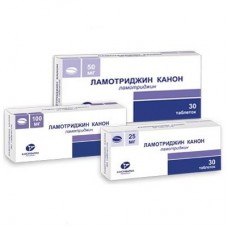Expiration date: 09/2025
Composition:
Dosage 25 mg:
One tablet contains:
Active substance: lamotrigine 25 mg
Excipients: hyprolose (hydroxypropyl cellulose) 4, 5 mg, carboximetilkrahmal sodium 3, 5 mg, lactose monohydrate 52 mg, magnesium hydroxycarbonate 34 mg magnesium stearate 1 mg
Dosage 50 mg:
One tablet contains:
Active substance: lamotrigine 50 mg
Excipients: hyprolose (hydroxypropyl cellulose) 7 mg, carboximetilkrahmal sodium 6 mg, 81 lactose monohydrate, 6 mg magnesium hydroxycarbonate 53, 8 mg magnesium stearate 1, 6 mg
Dosage 100 mg:
One tablet contains:
Active substance: lamotrigine 100 mg
Excipients: hyprolose (hydroxypropyl cellulose) 11 mg, sodium 9 carboximetilkrahmal, 5 mg, lactose monohydrate 120 mg, magnesium hydroxycarbonate 77 mg, magnesium stearate 2. 5 mg
Description
Round, valium tablets white or almost white, c chamfer (dosage 25 mg) or with a facet and valium (dosage of 50 mg and 100 mg).
Pharmacotherapeutic group: antiepileptic drug
Pharmacological action:
Pharmacodynamics
Lamotrigine is a blocker of potential-dependent sodium channels. In the culture of neurons, it causes a potential-dependent blockade of recurring impulses and suppresses the abnormal release of glutamic acid (an amino acid that plays a key role in the development of epileptic seizures), as well as inhibits the depolarization caused by glutamate.
Pharmacokinetics
Suction
Lamotrigine is rapidly and completely absorbed from the intestine, almost without being subject to presistemnomu metabolizmu first passage. The maximum concentration (Cmax) in plasma is approximately 2. 5 hours after oral administration. The time to reach Cmax slightly increased after a meal, but extent of absorption remains unchanged. The pharmacokinetics is linear when a single dose to 450 mg (the highest dose investigated).
Distribution
Lamotrigine is associated with blood plasma proteins is approximately 55 %. The volume of distribution (V p) is 0, 92-1, 22 l/kg.
Metabolism
In the metabolism of lamotrigine is involved with the enzyme ??????????????????????????????????? (D. O.-glucuronyltransferase). Lamotrigine to a small extent increases its own metabolism depending on the dose.
Excretion
In healthy adults the clearance of lamotrigine in a state of equilibrium concentrations averaged 39 ± 14 ml/min. Lamotriginelamotrigine to glucuronides, which are excreted by the kidneys. Less than 10% of the drug appears kidneys in an unmodified form, about 2 % intestinal. Clearance and half-life (T½) is not dose-dependent. T½ in healthy adults averages from 24 h to 35 h in patients with Gilbert syndrome was observed reduced clearance of the drug by 32% in comparison with the control group, however, did not go beyond the limits of normal values for the General population. Mean elimination half-life is reduced to approximately 14 h together with the appointment of drugs that stimulate glukuronizatia such as carbamazepine and phenytoin, and rises to an average 70 h the joint appointment with valproate.
In children, clearance of lamotrigine when calculated on a body weight higher than in adults; it is highest in children up to 5 years. T½ is usually shorter than in adults. Its average value is approximately equal to 7 h together with the appointment of drugs that stimulate glukuronizatia such as carbamazepine and phenytoin, and rises to an average of 45 - 50 h the joint appointment with valproate.
From elderly patients is clinically relevant differences in clearance of lamotrigine compared to younger patients is not detected.
With a significant decline in renal function may require dose reduction of lamotrigine.
In patients with moderate to severe hepatic insufficiency the dose of lamotrigine should be reduced (see "Method of application and dosage").
Indications for use:
- Epilepsy (partial and generalized seizures, including tonico-clauniceskie convulsions, as well as the seizures when syndrome Lennox-gusto) as part of combination therapy or monotherapy in adults and children older than 12 years;
- Epilepsy (partial and generalized seizures, including tonico-clauniceskie convulsions, as well as the seizures when syndrome Lennox-gusto) as part of combination therapy in children from 3 to 12 years;
- Monotherapy of typical absence seizures;
- To prevent mood disorders (depression, mania, hypomania, mixed episodes) in adults with bipolar affective disorder.
Contraindications:
- Hypersensitivity to lamotrigine or any component of the drug;
- Deficiency of lactose, lactose intolerance, malabsorption glucosegalactose;
- Children up to 3 years;
- Pregnancy; breastfeeding.
With caution
The liver and kidneys.
Use during pregnancy and breastfeeding:
Fertility
Studies on the reproductive function of animals during the use of lamotrigine did not reveal fertility. Studies on the effect of lamotrigine on human fertility have not been conducted.
Pregnancy
The risk associated with antiepileptic drugs (AEDs) in General.
Women capable of childbearing must obtain the recommendation of specialists.
If a woman is planning pregnancy, the need for treatment of ELVs have to be revised. In women the treatment of epilepsy, should avoid sudden cessation of antiepileptic therapy, as this may result in the resumption of seizures that could have serious consequences for women and the unborn child. In the offspring of mothers treated with AEDs, the risk of congenital malformations is increased 2-3 times in comparison with the expected incidence in the General population, amounting to about 3 %. The most frequently reported defects are cleft lip, cardiovascular malformations and heart defects neural tube development. Multiple therapy probe is associated with a higher risk of congenital malformations than monotherapy, therefore, should be applied to Monterey.
The risks of taking lamotrigine
Lamotrigine has a slight inhibitory effect on dihydrofolic acid reductase and therefore, in theory, can lead to increased risk of developmental disorders of the embryo and fetus as a result of lower levels of folic acid. You should consider the possibility of taking folic acid while planning pregnancy and in the early stages of pregnancy. Post-marketing surveillance data from several prospective pregnancy registers allowed us to document the pregnancy outcomes of approximately 2000 women who received monotherapeutic during the first trimester of pregnancy. In General, the data do not confirm a General increase of risk of development of congenital malformations, however, a limited number register the pregnancy, there are reports of increased risk of malformations of the oral cavity. Study type case-control found no increase in the risk of malformations of the oral cavity in comparison with other defects arising due to the use of lamotrigine. Data when using the drug in combination therapy is insufficient to assess whether the risk of malformations from other drugs used in combination with lamotrigine. As with other AEDs, lamotrigine should be administered during pregnancy only if the expected benefit outweighs the potential risk.
Physiological changes during pregnancy can influence the concentration and/or therapeutic effect. There are reports of the decrease concentrations of lamotrigine during pregnancy. The drug administration should be provided as tactics of management of patients.
Breastfeeding
Lamotrigine in varying degrees, enters the breast milk, the total concentration of lamotrigine in infants may reach approximately 50% of the concentration of lamotrigine was his mother. Thus, some babies are breastfed, the serum concentrations of lamotrigine may reach levels at which pharmacological effects occur. It is necessary to relate the potential benefit of feeding of breast milk and the risk of possible adverse reactions in the baby.
Method of application and dose:
Inside. If the calculated dose of lamotrigine (for example, when administered to children or patients with impaired liver) cannot be divided into an integer number of tablets a lower dosage, then the patient should be assigned to this dose, which corresponds to a closest value of the whole tablet in the lower dosage.
In patients taking medicinal products where the pharmacokinetic interaction with lamotrigine is currently not known, should be used mode, recommended for appointment of lamotrigine in combination with drugs valproeva acid. In children with body weight less than 25 kg or calculated maintenance dose in children is less than 25 mg/day, the drug Lamotrigine Canon should not be assigned.
In case of resumption of reception of lamotrigine, physicians should evaluate the need to increase the dose in patients who stopped taking the drug for any reason, since high initial doses and exceeding the recommended doses is associated with risk of severe rash. The longer the elapsed time after the last administration of the drug, the more caution should raise the dose to a maintenance. If the time after discontinuation for more than 5 half-lives, the dose of lamotrigine should be increased to support under the relevant scheme.
It is not recommended to renew the appointment of lamotrigine patients who stopped taking the drug in connection with the appearance of the rash, except in cases when the potential benefit of the drug clearly outweighs the potential risks.


